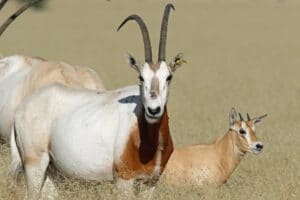Oryx five years on
On March 14, 2016, scimitar-horned oryx set foot on Chadian soil after an absence of almost 40 years. Welcomed back home like long-lost sons and daughters, the oryxs’ return was the fruit of cooperation between many players working hand in hand under the leadership of the Government of Chad and the Environment Agency Abu Dhabi.

Five years on and eight shipments later, a further 200 oryx have joined the initial twenty-five. Today, more than 360 oryx roam free in the Ouadi Rimé-Ouadi Achim Game Reserve, edging us closer and closer to our initial milestone of 500 breeding adults. Ultimately, we all want to see so many healthy and secure oryx that their conservation status is reclassified from Extinct in the Wild to a lower category of threat.

Of the initial 25 founders, at least 16 and possibly 19 are still alive. One female, initially named Blue 23 but now recollared as Red 02 (photo), has produced five calves, and others have performed similarly, producing a total of 42 calves, of which most have survived.

Conservation of wildlife and the restoration of extinct or critically endangered species is not a simple, one-off undertaking but a constant battle requiring major and permanent commitment. Overhunting saw the oryx disappear from Africa in the 1980s but there will always be new threats and new challenges moving forwards. Bushfire is now a major concern, something that hardly ever occurred in the past. Solid partnership has so far enabled us to achieve some truly remarkable results and it is this same spirit of working together that will ensure the growth and prosperity of the oryx population and its struggle back from the brink.
The Scimitar-horned Oryx Reintroduction Programme in Chad is a joint initiative of the Government of Chad and the Environment Agency–Abu Dhabi. Under the overall leadership and management of the Environment Agency–Abu Dhabi, on-the-ground implementation of the project is carried out by the Sahara Conservation Fund. In 2019, following a highly successful first phase of activities, EAD generously agreed to develop and fund a second five-year phase of operations. Phase II of the project maintains focus on building the oryx population but also adds new Sahelo-Saharan species to the mix, including the Critically Endangered addax antelope (Addax nasomaculatus), dama gazelle (Nanger dama), and North African ostrich (Struthio camelus camelus).


